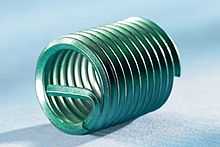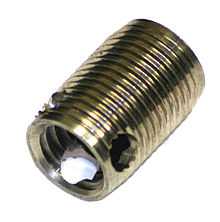Threaded insert



A threaded insert, also known as a threaded bushing, is a fastener element that is inserted into an object to add a threaded hole. They may be used to repair a stripped threaded hole, provide a durable threaded hole in a soft material, place a thread on a material too thin to accept it, mold or cast threads into a workpiece thereby eliminating a machining operation, or simplify changeover from unified to metric threads or vice versa.[1]
Types
Thread inserts come in many varieties, depending on the application. Threaded inserts for plastics are used in plastic materials and applied with thermal insertion or ultrasonic welding machines.
Manufacturers of knock-down furniture often ship the parts with threaded inserts and other kinds of knock-down fasteners pre-installed.
People who use sheet metal or sandwich panel or honeycomb sandwich-structured composite often install threaded inserts to spread shear, tension, and torque loads over a larger area of the material.[2]
Captive nut
Captive nuts, also known as insert nuts, are threaded inserts with a knurled base that digs into thin panels. They are used on thin sheet metal that is too thin to be threaded or in soft panels that are too weak to be threaded. They are installed by pressing them in with an arbor press.[3] Mounted in a sheet metal carrier to facilitate attachment, they are known as cage nut or clip-on nut.
Additionally, the captive nut style of threaded inserts are commonly used in plastic casings, housing, and parts to create a metal thread (typically: Brass or Stainless Steel) to allow for screws to be used in the assembly of many consumer electronics and consumer products. Thermal Insertion is the process used to apply heat and pressure to install or melt the threaded insert into a molded hollow boss of a plastic part..[4] Ultrasonic Insertion is the process used to apply vibration and pressure to install or melt the threaded insert into a molded hollow boss of a plastic part. The plastic material typically reforms around the knurled body of the threaded insert to ensure a good pull strength.
Externally threaded insert
Externally threaded inserts have threads on the outside and inside of the insert. The insert is threaded into a pre-tapped hole, or some inserts tap their own threads in a drilled or molded hole. It is then anchored by various means, such as a nylon locking element. Inserts that are anchored via Loctite are more commonly known by the trademarked name E-Z Lok. A thin walled solid bushing insert by the trademarked name TIME-SERT is locked in by rolling the bottom few internal thread into the base material with a special install driver which will permanently lock the insert in place.[citation needed] Key locking inserts, more commonly known by the trademarked name Keenserts, use keys that are hammered into grooves through the threads, permanently locking the insert.[5][6][7] Inserts that are self-tapping and lock via friction are more commonly known by the trademarked names Tap-lok or Speedserts.
Helical insert
A helical insert is an insert made of coiled wire. Another common generic name is screw thread insert (STI), although many users persist in calling them all by a prominent brand name, the registered trademark Heli-Coil.
Mold-in inserts
Mold-in inserts are internally threaded and have a specially shaped outer diameter to anchor the insert in plastic. The insert is placed in the mold of an injection molded part beforehand. The mold is then closed and filled with the plastic filling in around the insert. These inserts can also be heated and pressed into pre-made thermoplastics.[8]
For softer more pliable plastics, hexagonal or square inserts with deep and wide grooves allow the plastic to flow and adhere. The process allows large product manufacture i.e. fuel tanks, boats etc., so the torque inserts may be of large thread sizes.
Press fit inserts
Press fit inserts are internally threaded and have a knurled outer diameter. They are pressed into a plain hole with an arbor press.[8]
See also
References
Notes
- ↑ "Newman Tools Inc". Newmantools.com. Retrieved 2012-02-29.
- ↑ "Delron Inserts for Honeycomb and Sandwich Panels" (pdf). Retrieved 2013-06-03.
- ↑ McMaster-Carr, p. 3150.
- ↑ Sullivan, G. & Crawford, L. (January/February 2003 ed.). "The Heat Stake Advantage". Plastic Decorating Magazine
- ↑ McMaster-Carr, p. 3204.
- ↑ McMaster-Carr, p. 3206.
- ↑ McMaster-Carr, p. 3207.
- ↑ 8.0 8.1 McMaster-Carr, p. 3209.
Bibliography
- McMaster-Carr catalog (114th ed.), McMaster-Carr.
- Sullivan, Gary & Crawford, Lance, "The Heat Stake Advantage". Plastic Decorating Magazine. January/February 2003 Edition. ISSN 1536-9870. (Topeka, KS: Peterson Publications, Inc.). Section: Assembly: pages 11-12, covers Sullivan & Crawford's article.